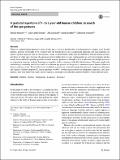A gestural repertoire of 1-to 2-year-old human children : in search of the ape gestures
Date
07/2019Metadata
Show full item recordAbstract
When we compare human gestures to those of other apes, it looks at first like there is nothing much to compare at all. In adult humans, gestures are thought to be a window into the thought processes accompanying language, and sign languages are equal to spoken language with all of its features. Some research firmly emphasises the differences between human gestures and those of other apes; however, the question about whether there are any commonalities is rarely investigated, and has mostly been confined to pointing gestures. The gestural repertoires of nonhuman ape species have been carefully studied and described with regard to their form and function-but similar approaches are much rarer in the study of human gestures. This paper applies the methodology commonly used in the study of nonhuman ape gestures to the gestural communication of human children in their second year of life. We recorded (n = 13) children's gestures in a natural setting with peers and caregivers in Germany and Uganda. Children employed 52 distinct gestures, 46 (89%) of which are present in the chimpanzee repertoire. Like chimpanzees, they used them both singly, and in sequences, and employed individual gestures flexibly towards different goals.
Citation
Kersken , V , Gomez , J-C , Liszkowski , U , Soldati , A & Hobaiter , C 2019 , ' A gestural repertoire of 1-to 2-year-old human children : in search of the ape gestures ' , Animal Cognition , vol. 22 , no. 4 , pp. 577-595 . https://doi.org/10.1007/s10071-018-1213-z
Publication
Animal Cognition
Status
Peer reviewed
ISSN
1435-9448Type
Journal article
Description
This project was made possible with the generous financial help of the Baverstock Bequest to the Psychology and Neuroscience Department at the University of St Andrews.Collections
Items in the St Andrews Research Repository are protected by copyright, with all rights reserved, unless otherwise indicated.

